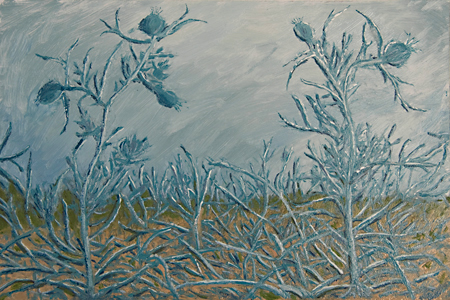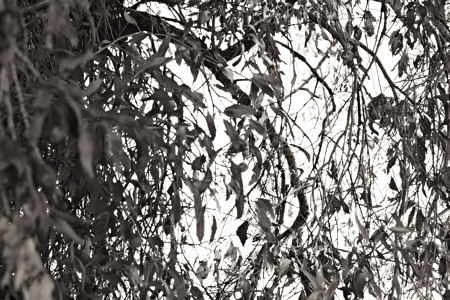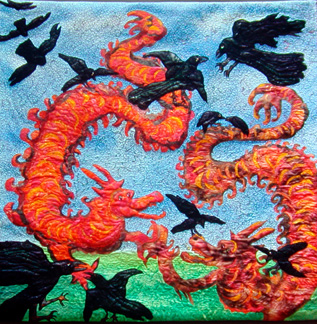Posted by June Underwood on October 31st, 2008
I am continuing to re- and re-read Schmid’s chapter on edges, because I’m not sure I have a decently full grasp of what he’s saying.
The book is Alla Prima: Everything I Know About Painting by Richard Schmid ($50 USD in soft cover from him; more from Amazon and more in hard cover).
Schmid begins his chapter by saying “Think about edges the way you would think about kissing someone…. Think of edges as exquisite subtleties, as the means to transmit romance, as ways to make your dabs or paint whisper or shout and reach nuances beyond the range of color. Think of them as visual poetry… but especially think of edges as you would the agents of expression in music….pianissimo (very soft), andante (flowing), allegro vivace (fast and lively), maestoso (majestic), fortissimo con sforzando (whamo!).
more… »
Posted by Steve Durbin on October 28th, 2008

Recent posts here on the topic of edges and their sharpness (or not) have been finding echoes in other places. For example, I’ve just read the intriguing but peculiar short story by Balzac, entitled The Unknown Masterpiece, which I learned of by reading that Picasso was asked to illustrate an edition. He (P) was apparently fascinated enough that he rented a studio in Paris thought to figure in the story; that’s where he painted Guernica.
more… »
Posted by Birgit Zipser on October 24th, 2008

Pitcher thistle in oil and as photo.
more… »
Posted by Steve Durbin on October 19th, 2008
Despite all the discussion and analysis on A&P, I seldom, if ever, carry it consciously in my head when I’m out photographing. If it happens to be there at the start, it soon flees as I focus on the subject. Sub-consciously, who’s to say? In any case, in my first outing after writing about complexity, I made some pictures that not only relate to that issue, but seem to have a loose resemblance to some of the drawings discussed. They also involve the edges June brought up recently, so I’ll have a look at that, as well.

more… »
Posted by Steve Durbin on October 19th, 2008
A new capability since our upgrade of WordPress is the tagging feature. Tags are like categories: labels to describe the post. But unlike categories, tagging is free-form; you can use any words or phrases you like, whether or not they’ve been previously used. Just as with categories, clicking on a tag label will show other posts bearing that tag. So it’s a great way to find similar content without having to search on a particular term. Searching doesn’t always work well, as a post might contain the search term without it being very characteristic of the post content.
You’ll notice in the sidebar (possibly scrolling down a bit) a list of recent tags, with their frequency indicated by intensity of blue and font size. That provides a snapshot of recent topics which can be more informative than our sometimes cryptic post titles. Clicking any of these also brings you to a list of posts so tagged.
So far, I’ve tagged just my last few posts to show how it works. We need some other tags in there! Feel free to go back and tag any old posts, and use tags if you like for future posts. On the post edit page, tags are added immediately below the compose area, right next to the category assignment list.
I hope tags will offer an easier way to find posts of interest and ones related to a post you’ve enjoyed. Let’s see if it works out that way. Meanwhile, any comments or suggestions would be appreciated!
Posted by Jay on October 17th, 2008
Last weekend I accompanied family members on a picnic along the waterfront and a trip to an apple orchard.
The skyline is plainly visible from the west bank of the river and I took a stock photograph of it. I then Photo Shopped this treatment. Makes me think of a mineral specimen. I’m feeling the itch to do another foam painting and this, or something similar, may serve as the source image.

more… »
Posted by June Underwood on October 16th, 2008
[Note: This post also appears on my personal blog, southeast main. Jay has persuaded me to cross-post as an efficiency matter. I find it changes my thinking to do it this way, which is a different, but also interesting, topic. Hi all — I’m glad to be back.]
I’m thinking about edges. I have a theory — or rather a “notion,” (which is a theory that is so diffuse it has no edges) — but anyway…..
My theory is that a lot of textile art maintains its textilishness via its edges. And this is in spite of the hand-dyed fabrics, surface design with fuzzy results, sheer fabrics, and other fuzzying techniques of contemporary textile artists. The edges of quilted art are often delineated by the quilting ; sometimes they are even more clearly portrayed with zigzag applique. Applique by itself lends itself to clean edges, as do commercial fabrics. Piecing fabric together gives a seam line, which makes an edge, even when the fabrics are close in color and value.
The clarity of edges in textiles tends to pull the textile toward something I think of as “good design” such as can be seen in magazine ads and hard-edged abstract art. This clarity has a certain appeal –it’s clean, not mushy, not sentimental. Clarity has a sureness of feel about it (which is probably why it’s so popular in advertisements). It’s also good for a certain kind of whimsicality, of child-like sensibility. The “faux representational” look in textile art often derives from its clear, often hard, edges.

Arabesque, 40″ x 40″, hand-dyed cottons and silk hanks, appliqued and machine quilted
more… »




